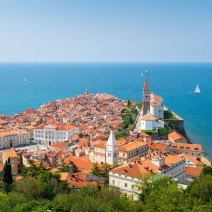Slovenia Travel Guide
Slovenia is a land of breathtaking natural beauty, rich cultural heritage, and relaxing outdoor adventures.
Slovenia has an estimated population of around 2.1 million people, with Slovenian as the official language and a high proficiency in English among locals. Its charming capital, Ljubljana, is celebrated for its vibrant atmosphere, historic architecture, and eco-friendly initiatives.
Slovenia offers a wealth of experiences for those seeking peace and tranquility. Highlights include the serene waters of Lake Bled with its iconic island church, the enchanting Postojna Caves, the beautiful Adriatic coastline at Piran, and the charming streets of Ljubljana’s Old Town.
We've outlined some general information that may be helpful to you when planning your next holiday to Slovenia.

Time Zone & Currency
Slovenia is one hour ahead of Greenwich Mean Time (GMT). The currency in Slovenia is the Euro.

Weather in Slovenia
Slovenia has a diverse climate, with warm summers (June to August) and mild, snowy winters (December to February). The coast enjoys a Mediterranean climate, while inland areas have a more continental climate.

Reading For Your Trip To Slovenia
The Hidden Europe by Francis Tapon
Slovenia: A Traveller's Guide by Brigitte G. M.
The Clockmaker by Dario Cortese
Best time to go to Slovenia
Slovenia is a wonderful destination year-round, with each season offering its own charm. The best time to visit is from May to September, when the weather is warm and perfect for outdoor exploration and enjoying the country’s natural beauty. For those seeking a quieter, more relaxed experience, the shoulder seasons of March to May or September to November are ideal, offering mild weather, fewer crowds, and vibrant scenery, whether it’s spring blossoms or autumn foliage.
Top Tourist Attractions In Slovenia
Food and drink in Slovenia
Slovenian cuisine is a delightful blend of Austrian, Italian, and Hungarian influences, with fresh, seasonal ingredients playing a key role. Some must-try dishes include:
- Potica: A traditional Slovenian pastry, often filled with walnut or honey, and rolled into a distinctive spiral shape.
- Idrija Žlikrofi: A unique type of dumpling from the town of Idrija, filled with a mix of potatoes, herbs, and spices.
- Jota: A hearty stew made from beans, sauerkraut, and potatoes, perfect for colder months.
- Kraški pršut: A famous Slovenian dry-cured ham, produced in the Karst region.
- Bled cake: A delicious layered dessert with vanilla cream, custard, and flaky pastry, originating from the iconic Lake Bled region.
- Slovenian cheese: Slovenia boasts a variety of artisanal cheeses, including the renowned Tolminc and Bovec cheeses, which are made using traditional methods and reflect the country’s rich dairy heritage.
Slovenia is also known for its wine, particularly white varieties such as Rebula and Malvasia, as well as the famous Cviček, a local red wine blend.
Slovenia Travel Guide FAQs
Can you give a brief history of Slovenia?
Slovenia has a rich and diverse history, shaped by its strategic position in Europe. Originally inhabited by various Slavic tribes, it was later part of the Roman Empire, followed by the Holy Roman Empire, and eventually the Austrian Empire. After World War I, Slovenia became part of the Kingdom of Yugoslavia. In 1991, Slovenia declared independence, marking the end of Yugoslavia. Since then, Slovenia has established itself as a peaceful, democratic nation with a strong cultural identity. Today, Slovenia is known for its stunning landscapes, vibrant capital city Ljubljana, and its commitment to sustainability and European integration.
Do I require a holiday visa to travel to Slovenia?
A valid passport is required for this holiday. EU citizens do not need a visa. Non-EU citizens should check their requirements.
Is Slovenia safe?
The destinations on your itinerary are generally safe, and our guides will always look out for your wellbeing. However, as with any large city, there may be opportunists and pickpockets. It’s important to stay alert, particularly at busy tourist spots, and to keep a close watch on your personal belongings. Use the hotel safe for valuables and carry a photocopy of your passport while exploring. Be especially cautious when using public transport.
Useful Links
- For up-to-date information regarding entry into Slovenia please see: www.gov.uk
- Official Slovenia Tourism Board: www.slovenia.info










